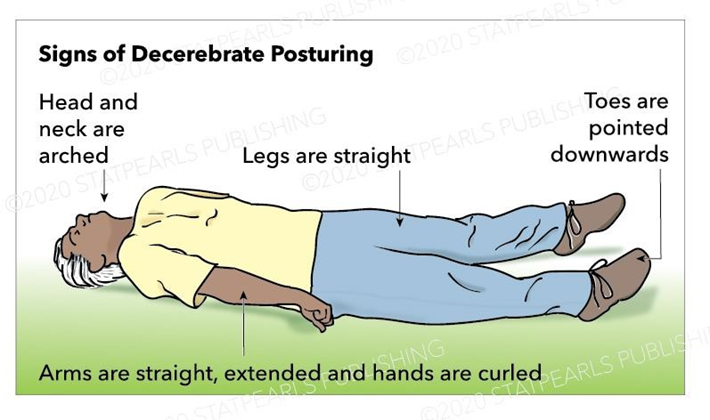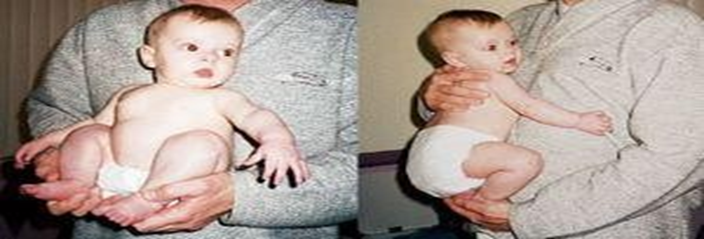The nurse is reviewing the record of a child with increased intracranial pressure and notes that the child has exhibited signs of decerebrate posturing. On assessment of the child, the nurse expects to note which characteristic of this type of posturing?
Adduction of the arms at the shoulders
Abnormal flexion of the upper extremities and extension and adduction of lower extremities
Flaccid paralysis of all extremities
Rigid extension and pronation of the arms and legs
The Correct Answer is D
D. This is the correct characteristic of decerebrate posturing. Decerebrate posturing is characterized by rigid extension and pronation (turning inward) of the arms and legs. It indicates severe neurological dysfunction and increased intracranial pressure, often involving damage to the brainstem.

A. This characteristic is not associated with decerebrate posturing. Adduction refers to movement toward the midline of the body, which is not typically observed in decerebrate posturing.
B. This description is not characteristic of decerebrate posturing. Decerebrate posturing involves extension, not flexion, of the upper extremities, along with extension and pronation (not adduction) of the lower extremities.
C. Flaccid paralysis refers to the absence of muscle tone and movement, which is not characteristic of decerebrate posturing. Decerebrate posturing involves increased muscle tone and abnormal, rigid extension of the arms and legs.
Nursing Test Bank
Naxlex Comprehensive Predictor Exams
Related Questions
Correct Answer is D
Explanation
This position, often referred to as the "knee-to-chest" position, is recommended during a cyanotic spell in infants with tetralogy of Fallot because it can help increase venous return to the heart and improve oxygenation. It's important for caregivers to understand this positioning as part of the management for hypercyanotic spells in children with this condition.

A. Placing the baby upright in an infant seat may help improve blood flow and oxygenation, but it's not the recommended position for managing cyanosis in a baby with tetralogy of Fallot.
B. Placing the baby with the head lower than the rest of the body could potentially worsen cyanosis by increasing right-to-left shunting of blood and decreasing pulmonary blood flow.
C. Placing the baby in a supine position with the head elevated worsens pulmonary blood flow by increasing systemic vascular resistance. This position can help worsen cyanosis by promoting better oxygenation.
Correct Answer is C
Explanation
C. Salicylates, such as aspirin, should be avoided in children and adolescents with viral symptoms due to the association with Reye's syndrome. Instead, acetaminophen or other non-steroidal anti-inflammatory drugs (NSAIDs) without salicylates should be used for fever and pain relief.
A. Reye's syndrome typically presents with symptoms such as fever, vomiting, and lethargy. However, there isn't a specific test for Reye's syndrome itself. Diagnosis is often based on clinical symptoms, history of aspirin use, and laboratory findings.
B. Reye's syndrome is associated with the use of aspirin (salicylates) in children and adolescents with viral infections, particularly influenza and chickenpox. Acetaminophen (Tylenol) is recommended instead of aspirin for fever and pain relief in children with viral illnesses.
D. There isn't a specific vaccine for Reye's syndrome. Reye's syndrome is not caused by an infectious agent that can be prevented through vaccination.
Whether you are a student looking to ace your exams or a practicing nurse seeking to enhance your expertise , our nursing education contents will empower you with the confidence and competence to make a difference in the lives of patients and become a respected leader in the healthcare field.
Visit Naxlex, invest in your future and unlock endless possibilities with our unparalleled nursing education contents today
Report Wrong Answer on the Current Question
Do you disagree with the answer? If yes, what is your expected answer? Explain.
Kindly be descriptive with the issue you are facing.
